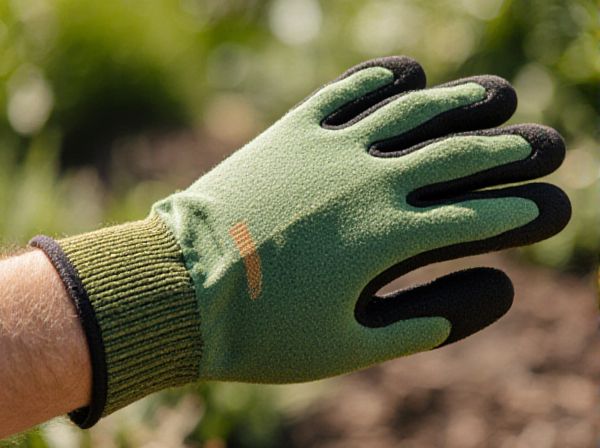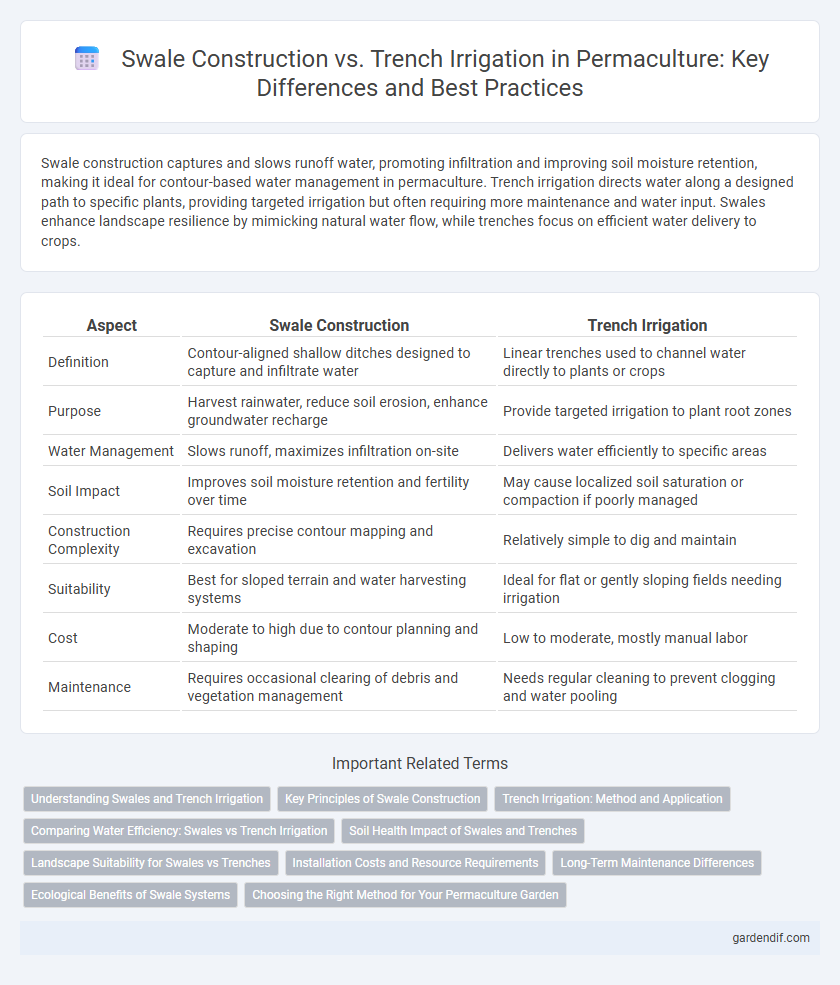
Swale construction vs trench irrigation Illustration
Swale construction captures and slows runoff water, promoting infiltration and improving soil moisture retention, making it ideal for contour-based water management in permaculture. Trench irrigation directs water along a designed path to specific plants, providing targeted irrigation but often requiring more maintenance and water input. Swales enhance landscape resilience by mimicking natural water flow, while trenches focus on efficient water delivery to crops.
Table of Comparison
| Aspect | Swale Construction | Trench Irrigation |
|---|---|---|
| Definition | Contour-aligned shallow ditches designed to capture and infiltrate water | Linear trenches used to channel water directly to plants or crops |
| Purpose | Harvest rainwater, reduce soil erosion, enhance groundwater recharge | Provide targeted irrigation to plant root zones |
| Water Management | Slows runoff, maximizes infiltration on-site | Delivers water efficiently to specific areas |
| Soil Impact | Improves soil moisture retention and fertility over time | May cause localized soil saturation or compaction if poorly managed |
| Construction Complexity | Requires precise contour mapping and excavation | Relatively simple to dig and maintain |
| Suitability | Best for sloped terrain and water harvesting systems | Ideal for flat or gently sloping fields needing irrigation |
| Cost | Moderate to high due to contour planning and shaping | Low to moderate, mostly manual labor |
| Maintenance | Requires occasional clearing of debris and vegetation management | Needs regular cleaning to prevent clogging and water pooling |
Understanding Swales and Trench Irrigation
Swale construction involves creating shallow, level ditches on contour lines to capture and infiltrate rainwater, promoting soil moisture retention and reducing erosion in permaculture design. Trench irrigation uses deeper, narrow channels to direct and control water flow towards plant roots, optimizing water efficiency in arid or sloped landscapes. Understanding the specific hydrological functions and placement of swales and trenches is essential for maximizing water conservation and improving overall ecosystem health in sustainable agriculture.
Key Principles of Swale Construction
Swale construction in permaculture emphasizes contour alignment to capture and infiltrate rainwater, effectively reducing soil erosion and promoting groundwater recharge. Unlike trench irrigation, swales are designed with berms on the downslope side to slow water flow and maximize absorption, enhancing soil moisture retention for plant growth. Key principles include gentle slope grading, sediment trapping, and strategic placement to support ecosystem health and sustainable water management.
Trench Irrigation: Method and Application
Trench irrigation involves digging shallow, linear channels to direct water flow efficiently across agricultural landscapes, promoting soil moisture retention and reducing runoff. This method enhances groundwater recharge by allowing water to infiltrate slowly, supporting plant roots and minimizing erosion in permaculture systems. Trench irrigation is particularly effective for contour planting on slopes, enabling sustainable water management tailored to diverse terrain conditions.
Comparing Water Efficiency: Swales vs Trench Irrigation
Swale construction captures and infiltrates rainwater directly into the soil, reducing runoff and promoting groundwater recharge, which enhances water efficiency in permaculture systems. Trench irrigation delivers water to plant roots but often results in higher evaporation and runoff compared to swales. Swales optimize natural water distribution and retention, making them more sustainable and efficient for water management in permaculture landscapes.
Soil Health Impact of Swales and Trenches
Swale construction enhances soil health by promoting water infiltration and reducing erosion, which supports microbial activity and nutrient retention. Trenches primarily facilitate water drainage but can lead to soil compaction and nutrient leaching if not managed properly. Integrating swales in permaculture systems fosters long-term soil fertility and resilience compared to conventional trench irrigation.
Landscape Suitability for Swales vs Trenches
Swale construction is ideal for gently sloping landscapes where water can be captured and allowed to infiltrate slowly, promoting soil moisture retention and reducing erosion. In contrast, trench irrigation suits flat or mildly uneven terrains where efficient water distribution directly to plant roots is critical without relying on gravity flow. Choosing between swales and trenches depends heavily on the land's slope, soil type, and watershed characteristics to optimize water management in permaculture systems.
Installation Costs and Resource Requirements
Swale construction typically involves higher initial installation costs due to earthmoving equipment and labor needed to create contour-based basins that capture and infiltrate water effectively. Trench irrigation generally requires less upfront investment, as it consists of simpler ditch digging and pipe systems, but it often demands more water resources and ongoing maintenance to prevent erosion and water loss. Choosing between swales and trench irrigation depends on balancing resource availability with long-term sustainability goals in permaculture design.
Long-Term Maintenance Differences
Swale construction in permaculture provides superior long-term water management by capturing and slowly infiltrating runoff, reducing soil erosion and minimizing maintenance compared to trench irrigation. Trenches often require regular clearing of sediments and repairs due to their open channels, which can lead to higher maintenance demands over time. Swales promote sustainable ecosystem health by enhancing groundwater recharge and supporting plant growth with less frequent intervention.
Ecological Benefits of Swale Systems
Swale construction enhances soil moisture retention and reduces erosion by capturing and slowly infiltrating rainwater along contour lines, promoting healthier plant growth and increased biodiversity. Unlike traditional trench irrigation, swales support natural water cycles, recharge groundwater, and create microhabitats that improve ecosystem resilience. These ecological benefits contribute to sustainable land management and long-term landscape productivity.
Choosing the Right Method for Your Permaculture Garden
Swale construction is ideal for permaculture gardens on sloped terrain, effectively capturing and slowly infiltrating rainwater to prevent erosion while enhancing soil moisture retention. Trench irrigation suits flat areas where targeted water delivery to plant roots maximizes efficiency and reduces water wastage. Assessing site topography, soil type, and water availability is crucial when choosing between swales and trenches to optimize water management and promote sustainable plant growth.
Swale construction vs trench irrigation Infographic

 gardendif.com
gardendif.com